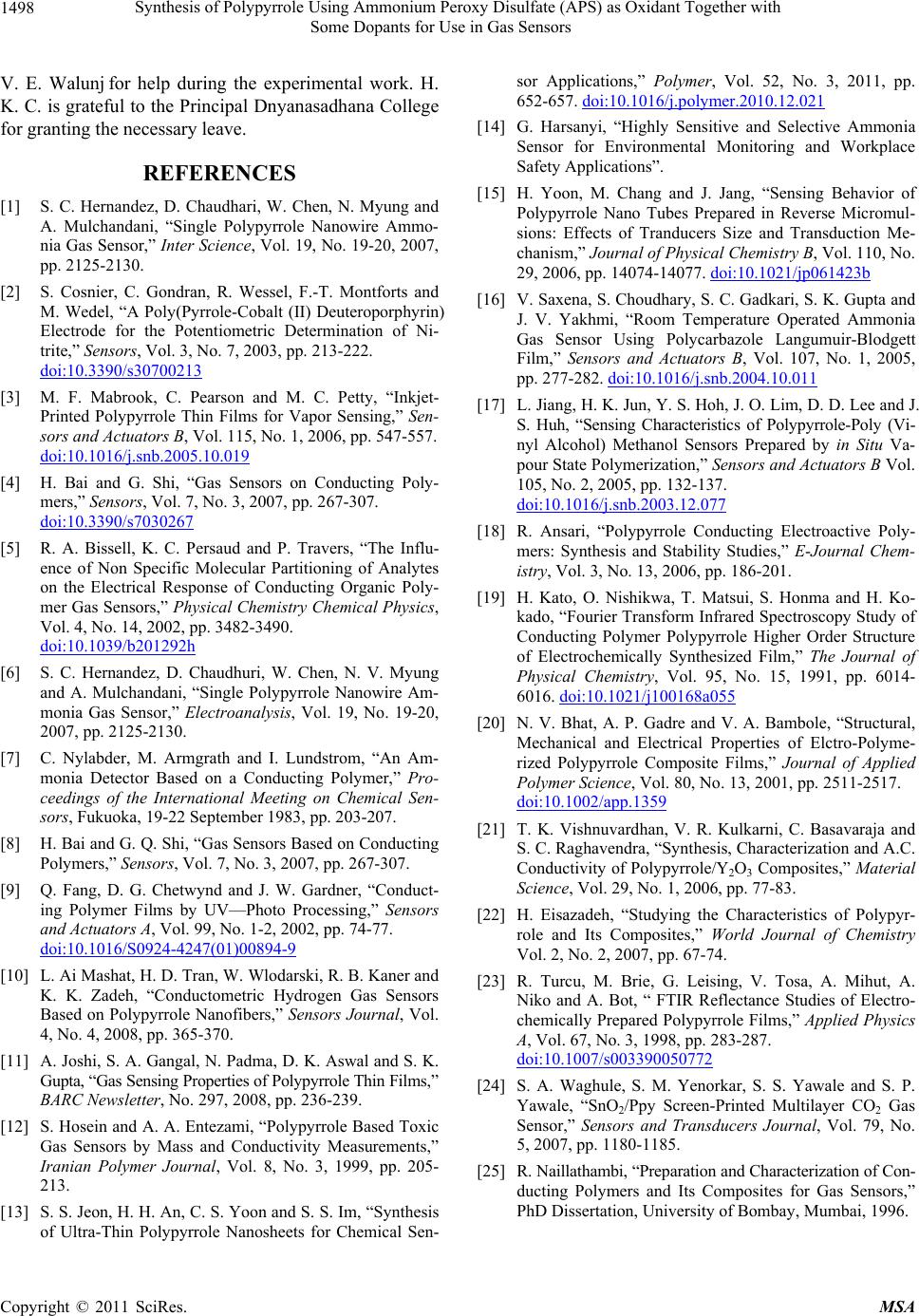
Synthesis of Polypyrrole Using Ammonium Peroxy Disulfate (APS) as Oxidant Together with
1498
Some Dopants for Use in Gas Sensors
V. E. Walunj for help during the experimental work. H.
K. C. is grateful to the Principal Dnyanasadhana College
for granting the necessary leave.
REFERENCES
[1] S. C. Hernandez, D. Chaudhari, W. Chen, N. Myung and
A. Mulchandani, “Single Polypyrrole Nanowire Ammo-
nia Gas Sensor,” Inter Science, Vol. 19, No. 19-20, 2007,
pp. 2125-2130.
[2] S. Cosnier, C. Gondran, R. Wessel, F.-T. Montforts and
M. Wedel, “A Poly(Pyrrole-Cobalt (II) Deuteroporphyrin)
Electrode for the Potentiometric Determination of Ni-
trite,” Sensors, Vol. 3, No. 7, 2003, pp. 213-222.
doi:10.3390/s30700213
[3] M. F. Mabrook, C. Pearson and M. C. Petty, “Inkjet-
Printed Polypyrrole Thin Films for Vapor Sensing,” Sen-
sors and Actuators B, Vol. 115, No. 1, 2006, pp. 547-557.
doi:10.1016/j.snb.2005.10.019
[4] H. Bai and G. Shi, “Gas Sensors on Conducting Poly-
mers,” Sensors, Vol. 7, No. 3, 2007, pp. 267-307.
doi:10.3390/s7030267
[5] R. A. Bissell, K. C. Persaud and P. Travers, “The Influ-
ence of Non Specific Molecular Partitioning of Analytes
on the Electrical Response of Conducting Organic Poly-
mer Gas Sensors,” Physical Chemistry Chemical Physics,
Vol. 4, No. 14, 2002, pp. 3482-3490.
doi:10.1039/b201292h
[6] S. C. Hernandez, D. Chaudhuri, W. Chen, N. V. Myung
and A. Mulchandani, “Single Polypyrrole Nanowire Am-
monia Gas Sensor,” Electroanalysis, Vol. 19, No. 19-20,
2007, pp. 2125-2130.
[7] C. Nylabder, M. Armgrath and I. Lundstrom, “An Am-
monia Detector Based on a Conducting Polymer,” Pro-
ceedings of the International Meeting on Chemical Sen-
sors, Fukuoka, 19-22 September 1983, pp. 203-207.
[8] H. Bai and G. Q. Shi, “Gas Sensors Based on Conducting
Polymers,” Sensors, Vol. 7, No. 3, 2007, pp. 267-307.
[9] Q. Fang, D. G. Chetwynd and J. W. Gardner, “Conduct-
ing Polymer Films by UV—Photo Processing,” Sensors
and Actuators A, Vol. 99, No. 1-2, 2002, pp. 74-77.
doi:10.1016/S0924-4247(01)00894-9
[10] L. Ai Mashat, H. D. Tran, W. Wlodarski, R. B. Kaner and
K. K. Zadeh, “Conductometric Hydrogen Gas Sensors
Based on Polypyrrole Nanofibers,” Sensors Journal, Vol.
4, No. 4, 2008, pp. 365-370.
[11] A. Joshi, S. A. Gangal, N. Padma, D. K. Aswal and S. K.
Gupta, “Gas Sensing Properties of Polypyrrole Thin Films,”
BARC Newsletter, No. 297, 2008, pp. 236-239.
[12] S. Hosein and A. A. Entezami, “Polypyrrole Based Toxic
Gas Sensors by Mass and Conductivity Measurements,”
Iranian Polymer Journal, Vol. 8, No. 3, 1999, pp. 205-
213.
[13] S. S. Jeon, H. H. An, C. S. Yoon and S. S. Im, “Synthesis
of Ultra-Thin Polypyrrole Nanosheets for Chemical Sen-
sor Applications,” Polymer, Vol. 52, No. 3, 2011, pp.
652-657. doi:10.1016/j.polymer.2010.12.021
[14] G. Harsanyi, “Highly Sensitive and Selective Ammonia
Sensor for Environmental Monitoring and Workplace
Safety Applications”.
[15] H. Yoon, M. Chang and J. Jang, “Sensing Behavior of
Polypyrrole Nano Tubes Prepared in Reverse Micromul-
sions: Effects of Tranducers Size and Transduction Me-
chanism,” Journal of Physical Chemistry B, Vol. 110, No.
29, 2006, pp. 14074-14077. doi:10.1021/jp061423b
[16] V. Saxena, S. Choudhary, S. C. Gadkari, S. K. Gupta and
J. V. Yakhmi, “Room Temperature Operated Ammonia
Gas Sensor Using Polycarbazole Langumuir-Blodgett
Film,” Sensors and Actuators B, Vol. 107, No. 1, 2005,
pp. 277-282. doi:10.1016/j.snb.2004.10.011
[17] L. Jiang, H. K. Jun, Y. S. Hoh, J. O. Lim, D. D. Lee and J.
S. Huh, “Sensing Characteristics of Polypyrrole-Poly (Vi-
nyl Alcohol) Methanol Sensors Prepared by in Situ Va-
pour State Polymerization,” Sensors and Actuators B Vol.
105, No. 2, 2005, pp. 132-137.
doi:10.1016/j.snb.2003.12.077
[18] R. Ansari, “Polypyrrole Conducting Electroactive Poly-
mers: Synthesis and Stability Studies,” E-Journal Chem-
istry, Vol. 3, No. 13, 2006, pp. 186-201.
[19] H. Kato, O. Nishikwa, T. Matsui, S. Honma and H. Ko-
kado, “Fourier Transform Infrared Spectroscopy Study of
Conducting Polymer Polypyrrole Higher Order Structure
of Electrochemically Synthesized Film,” The Journal of
Physical Chemistry, Vol. 95, No. 15, 1991, pp. 6014-
6016. doi:10.1021/j100168a055
[20] N. V. Bhat, A. P. Gadre and V. A. Bambole, “Structural,
Mechanical and Electrical Properties of Elctro-Polyme-
rized Polypyrrole Composite Films,” Journal of Applied
Polymer Science, Vol. 80, No. 13, 2001, pp. 2511-2517.
doi:10.1002/app.1359
[21] T. K. Vishnuvardhan, V. R. Kulkarni, C. Basavaraja and
S. C. Raghavendra, “Synthesis, Characterization and A.C.
Conductivity of Polypyrrole/Y2O3 Composites,” Material
Science, Vol. 29, No. 1, 2006, pp. 77-83.
[22] H. Eisazadeh, “Studying the Characteristics of Polypyr-
role and Its Composites,” World Journal of Chemistry
Vol. 2, No. 2, 2007, pp. 67-74.
[23] R. Turcu, M. Brie, G. Leising, V. Tosa, A. Mihut, A.
Niko and A. Bot, “ FTIR Reflectance Studies of Electro-
chemically Prepared Polypyrrole Films,” Applied Physics
A, Vol. 67, No. 3, 1998, pp. 283-287.
doi:10.1007/s003390050772
[24] S. A. Waghule, S. M. Yenorkar, S. S. Yawale and S. P.
Yawale, “SnO2/Ppy Screen-Printed Multilayer CO2 Gas
Sensor,” Sensors and Transducers Journal, Vol. 79, No.
5, 2007, pp. 1180-1185.
[25] R. Naillathambi, “Preparation and Characterization of Con-
ducting Polymers and Its Composites for Gas Sensors,”
PhD Dissertation, University of Bombay, Mumbai, 1996.
Copyright © 2011 SciRes. MSA